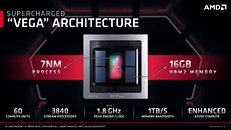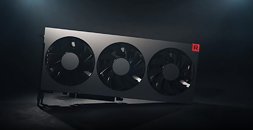Thursday, January 10th 2019

NVIDIA CEO Jensen Huang on Radeon VII: "Underwhelming (...) the Performance is Lousy"; "Freesync Doesn't Work"
PC World managed to get a hold of NVIDIA CEO Jensen Huang, picking his thoughts on AMD's recently announced Radeon VII. Skirting through the usual amicable, politically correct answers, Jensen made his thoughts clear on what the competition is offering to compete with NVIDIA's RTX 2000 series. The answer? Vega VII is an "underwhelming product", because "The performance is lousy and there's nothing new. [There's] no ray tracing, no AI. It's 7nm with HBM memory that barely keeps up with a 2080. And if we turn on DLSS we'll crush it. And if we turn on ray tracing we'll crush it." Not content on dissing the competition's product, Jensen Huang also quipped regarding AMD's presentation and product strategy, saying that "It's a weird launch, maybe they thought of it this morning."Of course, the real market penetration of the technologies Jensen Huang mentions is currently extremely low - only a handful of games support NVIDIA's forward-looking ray tracing technologies. That AMD chose to not significantly invest resources and die-space for what is essentially a stop-gap high-performance card to go against NVIDIA's RTX 2080 means its 7 nm 331 mm² GPU will compete against NVIDIA's 12 nm, 545 mm² die - if performance estimates are correct, of course.The next remarks came regarding AMD's FreeSync (essentially a name for VESA's Adaptive Sync), which NVIDIA finally decided to support on its GeForce graphics cards - something the company could have done outright, instead of deciding to go the proprietary, module-added, cost-increased route of G-Sync. While most see this as a sign that NVIDIA has seen a market slowdown for its G-Sync, added price-premium monitors and that they're just ceding to market demands, Huang sees it another way, saying that "We never competed. [FreeSync] was never proven to work. As you know, we invented the area of adaptive sync. The truth is most of the FreeSync monitors do not work. They do not even work with AMD's graphics cards." In the wake of these word from Jensen, it's hard to understand the overall silence from users that might have their FreeSync monitors not working.
Reportedly, NVIDIA only found 12 out of 400 FreeSync-supporting monitors to support their G-Sync technology automatically in the initial battery of tests, with most panels requiring a manual override to enable the technology. Huang promised that "We will test every single card against every single monitor against every single game and if it doesn't work, we will say it doesn't work. And if it does, we will let it work," adding a snarky punchline to this matter with an "We believe that you have to test it to promise that it works, and unsurprisingly most of them don't work." Fun times.
Source:
PC World
Reportedly, NVIDIA only found 12 out of 400 FreeSync-supporting monitors to support their G-Sync technology automatically in the initial battery of tests, with most panels requiring a manual override to enable the technology. Huang promised that "We will test every single card against every single monitor against every single game and if it doesn't work, we will say it doesn't work. And if it does, we will let it work," adding a snarky punchline to this matter with an "We believe that you have to test it to promise that it works, and unsurprisingly most of them don't work." Fun times.



270 Comments on NVIDIA CEO Jensen Huang on Radeon VII: "Underwhelming (...) the Performance is Lousy"; "Freesync Doesn't Work"
Other than that, I see no trace of a "boom" - all other market segments are more or less static, after all. The growth in Vega sales is understandable, and Polaris sales are only slightly up. Still, quite impressive that there's no drop in semi-custom revenue considering how far into the current console cycle we are.
Supporting freesync though is a good move, finally. A lot of people are already salty because nVidia has stupid high prices, but now you gotta pay another stupid high price for the gsync screen? Jensen isn't THAT stupid... he must have realized that supporting freesync would be a good move and potentially get him more sales form the crowd that might be interested in buying nVidia right now, but not paying the price for gsync. They can keep gsync for the extreme high end crowd with the money and the will to spend it on that, and allow freesync for everyone else... rather than handing sales to AMD because they don't support freesync.
The Vega integrated in Ryzen APUs are embedded GPUs. An example of "semi-custom" is consoles, which are also embedded GPUs. AMD's graph is quite clear in this distinction: integrated (many architectures), mainstream discreet (Polaris), and high performance discreet (Vega).
Also, if AMD didn't do internal licensing, Vega APUs wouldn't affect this graph at all, as they would then fall entirely under the purview of the CPU division.
Hades Canyon is a semi-custom embedded GPU too.
AMD owns all of the Radeon and x86 IPs/licenses. As long as it has an AMD sticker on it, AMD's legal team takes care of it. There's no "internal licensing" because RTG exists in name only.
I have misread the charts a bit, though. After checking how AMD organizes this, Enterprise, Embedded, and Semi-custom is one division, while Compute and Graphics is another, where RTG is roughly half. It seems they've stopped reporting RTG earnings separately, at least from the latest earnings announcements. What that does tell us, without a doubt, is that "embedded" does not include APUs, at least not outside of embedded-only APUs - even if these are identical silicon to consumer ones, just with a different name and slightly different microcode. They still get silicon from the same wafers, through the same binning process, with the same designs, but they're separate business units, and thus have separate money. You can't have one pay the costs and the other earn the revenue without a matching payment in-between. In other words, the only way consumer Vega APUs fit into this is in the red block at the top - which is also marked with the same logo as the retail boxes for those chips are. Crypto likely represents the majority of that growth, but it'd be surprising if APUs didn't also add to that.
Thanks Camm & Valantar, this would make for a big reception in 2015!
Blame the HDMI Forum for being really slow on the uptake, not AMD for making adaptive sync support available in the Xbox One.
Also, while you're right that Freesync over HDMI is a proprietary extension to the HDMI standard, AFAIK it's still part of the open (as in free-to-implement) FreeSync standard, and should as such not be any problem for Nvidia to adopt even before HDMI 2.1 comes knocking. If HDMI 2.0 is anything to go by, it'll still be a few years before we see displays adopting it, after all.
Edit: damn autocorrect.
AMD had a lot of people there to convince. I'm sure NVIDIA was resistant in the name of defending G-Sync.